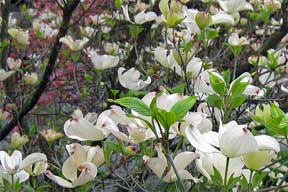Few landscape plants are as truly American or as deeply loved and appreciated as flowering dogwood. From Massachusetts to Florida, then west to the Great Lakes and to Texas, dogwood blooms wild in the woods in early spring. Picturesque sprays of white flowers, set on delicate branches, unfold just as the leaves of other forest trees are partially out. The effect is much like an Oriental print, yet truly American.
It is no small display you’ll see as you drive through the woods when dogwood is blooming. The white of the dogwood blends delicately with the pink of redbud, the light red of young maple leaves and the soft green of other young leaves, then all is deeply accented by the dark green of red cedar.

This pageant of dogwood, lovely and wild, starts in early April near the Gulf and as the season progresses, moves north through the wooded, mountain areas of northern Georgia, Tennessee and Kentucky. By the second or third week of April this great spring show has raced through the Ozarks to reach the‘Missouri River. And just as the season is moving up the Mississippi and Missouri valleys of the Midwest, so, too, is the season advancing up the Appalachian forests of the East.
Along the West Coast, another species of dogwood, similar to the flowering dogwood of the East and Midwest, but larger, blooms among the forest trees of California, Oregon and Washington.
Just as dogwood dominates the spring show in the woods, so, also, does it serve as a basic framework for many spring garden compositions. Whole cities are brightened by its blossoms. In Savannah, Georgia, dogwood blends with the pink of azaleas to turn the city into a wonderland of beauty in early April. In Atlanta a few days later great sections are bright with dogwood.
Farther north at Quincy, Illinois (but in early May), beautifully shaped dogwood trees in white and pink reach out from lawns and gardens to give the city new charm.
Not Petals at All
Flowering dogwood is a small, graceful tree about 15 feet high, rarely going to 30 feet. Branches are set in horizontal tiers in a manner that turns each blossom to the sun. Leaves are oval, three to six inches long.
The showy parts of the blossoms are, botanically speaking, not petals as in most flowers, but actually the bud scales or bracts, which enclose the small cluster of tiny yellow and green real Howers. The bud scales, four to each blossom, start to grow as they unfold, so that the tiny clusters of true Howers are grouped in the center of the four large white bracts.
In the wild, dogwood blossoms are white, but a pink form was found years ago and from this tree nurserymen have propagated others by grafting so that today it may be purchased in both the pink and the white forms.
Dogwood does well in a rich, moist soil or in a soil containing gravel, but overlaid with a thick layer of decaying leaves such as it finds in the woods. It likes some shade, growing well among other trees, but it will grow in the sun. Where climatic conditions are not too favorable, but where it will still grow, a northern or western exposure is best, with protection from spring sun, so that the tree is held back in early spring. Dogwood is hardy at Rochester and Buffalo in New York State, but may winterkill in the Adirondacks. In the Midwest it grows in the woods in abundance to central Missouri, but thrives in gardens far north of this area.
Transplanting Not Easy
Transplanting is best done in the spring and nursery grown stock moves easier than trees dug from the woods. Many nurserymen sell only balled and burlapped trees as they are more likely to live. But young, bare-rooted trees will usually survive if special care is taken that they are dug in the nursery with plenty of fine roots, and handled so that they are never allowed to dry out from the time they are dug, until planted.
Bare-rooted stock should have the ragged ends of the roots clipped with a clean, sharp cut and then the entire root system dipped in thin mud just before planting. The hole should be sufficiently large to hold the roots without cramping or bending. Rich loam should be worked in around the roots and pressed down. Water thoroughly.
Both bare-rooted and balled and burlapped trees should be set at the same depth at which they grew in the nursery.
The blooming period of flowering dogwood is quite long. At Quincy, Illinois, the trees were in full bloom last year on May 3. On May 17 some of the blossoms were beginning to fade, but the trees were still attractive.
Dogwood blooms about three weeks after forsythia, but overlaps the blooming period of redbud so that the two are handsome together before the redbud has faded.
Attractive compositions in the garden can also be worked out between dogwood and the following shrubs which are in bloom at the same time: Japanese kerria, Hugonis rose, Tatarian honeysuckle and lilac. Or use it with the following colorful perennials which are also in bloom at this period: Virginia bluebells, basket of gold, sweet williams, moss phlox, iris and mid-season tulips.
Whether in the wild or in gardens, dogwood is a plant you’ll enjoy. And besides its colorful splash in early spring, it is attractive at other seasons through the bright red berries of September and October, the scarlet fall color and the interesting branching as seen in winter.
